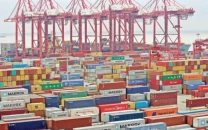Collapsing demand and inflation
State Bank of Pakistan needs to launch comprehensive emergency lending schemes

Representational image. PHOTO: REUTERS
Aggregate domestic demand has two components – private sector demand and government sector spending. The contribution of each sector to excess domestic demand is indicated by the aggregate borrowing of the sector from the banking system.
In recent years, private sector borrowing has been around 20% of total bank lending mostly for working capital of businesses while small amounts have been used for consumer loans and for some investment. The main contributor to excess domestic demand in Pakistan has been the persistently high government budget deficit and bank borrowing to finance it.
The trend in private sector borrowing is likely to be accentuated in present circumstances after the spread of the epidemic has corroded the functioning of the economy domestically and in view of the global economic meltdown.
Most businesses will be understandably reluctant to make new investments in a highly uncertain economic environment in the short to medium term.
Even consumer demand is sharply subdued as lockdowns and general health concerns have resulted in people voluntarily choosing isolation or social distancing, factors which combined with precautionary savings of even those with jobs and incomes have reduced private demand for goods and services.
The sharp drop in private consumption has resulted in lower sales volumes for producers and commercial operators, who are now battling for their survival, if not confronted with the prospect of actual closure of operations.
For them, therefore, the obvious first step has been to trim their costs, with the fastest way of achieving this objective being to lay off labour, who are in turn consumers of goods and services that these enterprises market.
Furthermore, private consumption is also getting affected by the drying up of foreign savings in the form of remittances.
Food, non-food demand
The reasons enumerated above fused with widespread losses of earning opportunities – loss of direct employment and prospects for casual wage labour for Pakistanis both domestically and globally – have not only significantly reduced household non-food spending (the demand for durables like motor vehicles, televisions, ACs, refrigerators, etc having been the most hit), but have also impacted food-related expenditures (the ‘exotic/luxury’ component having been essentially suspended as a more frequent element of consumption).
Ask any middle-class household and they will confirm how they are consuming less of both.
So, one component of aggregate demand has collapsed both globally and domestically. And although both demand and supply have been severely damaged and are feeding onto each other, there has been a larger drop in demand – it has fallen at a faster rate than the disruption in supply chains that enable the availability of consumption goods.
The effects of a demand shock are larger, always more significant than that of a shock to supply chains.
This drop in consumption has obviously hit government tax revenues gravely, diminishing its fiscal space further for undertaking a major relief operation. Its relief package – although grossly overstated at Rs1.2 trillion – to assist the poorest households and those who have been furloughed will, at best, have only partially restored the lost demand.
Limited inflationary risk
So, what do these developments, seriously dampening aggregate demand, entail for the rate of inflation over the next quarter or two?
In this writer’s view, inflation going forward will not be a worrying factor – not that inflation should give us sleepless nights anyway considering the crippling effects of Covid-19 both globally and at home.
There is limited risk for inflation under these conditions, except perhaps for food items, where ensuring a steady supply of goods along with temporary withdrawal of taxes on food products and inputs should keep inflation well under control.
Therefore, a strategy to choke demand by maintaining high real interest rates – in an economy actually struggling to stay alive – doesn’t make for an understandable policy measure under present conditions. Where is the demand that the policy is trying to stifle?
Since the present set of circumstances is characterised by the escalation in non-performing loans and a significant fall in, if not evaporation of, individual incomes – resulting from the sharp rise in unemployment – we need a strong response, well beyond cutting interest rates.
To begin with, we need to jettison the continuing adherence to the rather simplistic craving for inflows of foreign capital in government securities. This policy has been driven by our desire to protect the exchange rate by following a policy of high interest rates, which was also to assist the maintenance of a low rate of inflation.
The dire times suggest the urgent need to both prevent the collapse of aggregate demand as well as provide much-needed liquidity to businesses, partly also because the preference for liquidity in such an environment fuels a dash for cash, putting the large number of small businesses – that tend to finance their inventories through deferred payments – and supply chains under greater stress.
The sharp drop in demand is severely impacting cash flow of businesses, exacerbating disinflationary pressures and heightening uncertainty about markets, the extent of output losses and the possible character of their suffering – permanent or temporary in nature.
To this end, therefore, the SBP needs to launch bigger and more comprehensive emergency lending schemes. To help fund the much-needed expansion of government relief programmes, it should literally print more money – a mere transfer of money from one pocket of government to another pocket of government (a policy option essentially blocked by a poorly designed IMF programme being thoughtlessly embraced and pursued).
The contribution of the resulting higher fiscal deficit to the current account would be manageable, partly because of plummeting international prices of commodities, especially oil, and partly because of the positive net external assistance inflows that would enable the financing of the external account.
The above measure will need to be supplemented by the SBP becoming less timid in its approach to improve the availability of liquidity for businesses to thwart likely insolvencies.
It should introduce zero-interest credit lines to assist the removal of supply-side bottlenecks, enabling the exploitation of underutilised productive resources. The reality today is that there can’t be any other approach.
The writer is a former State Bank of Pakistan governor
Published in The Express Tribune, April 27th, 2020.
Like Business on Facebook, follow @TribuneBiz on Twitter to stay informed and join in the conversation.

















COMMENTS
Comments are moderated and generally will be posted if they are on-topic and not abusive.
For more information, please see our Comments FAQ